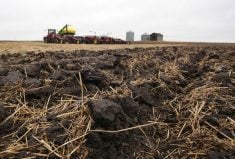Underwear and tea are used to determine biological activity in the soil because microbes are fond of the undergarment
Eat my shorts. This jibe issued by cartoon character Bart Simpson has a whole new meaning with the Soil Your Undies project.
The experiment that uses men’s underwear is a visual and hands-on way to study microbial activity and determine soil health.
“If there’s not much left of the undies after a growing season, you have good biological activity, which indicates healthy soil,” said Kris Nichols, a soil microbiologist with Alberta’s Food Water Wellness Foundation and director of research with Canadian Organic Growers.
Research is moving into its second of three seasons through COG’s Saskatchewan-based Regenerative Organic Oats project funded by partners at Nature’s Path and Riverside Natural Foods. It works with oat growers who are working toward regenerative organic certification.
“We’re trying to work with these farmers to be able to implement some of the practices and tools that can allow them to qualify for that certification,” said Nichols.
She was part of a better soil health panel during the recent Organic Connection Conference and Trade Show in Saskatoon.
“Oftentimes so much in farming, we look at productivity above ground, but what we’re really trying to focus in on now is we’re learning so much more about the importance of soil,” she said.
The experiment calls for nylon stockings, white cotton briefs, and green and black tea. The underwear and tea bags are placed separately into a nylon stocking, which doesn’t degrade in soil.
The underwear and nylon are weighed and then buried about 15 centimetres deep. At the end of the growing season, they are dug up and reweighed to see how much underwear remains.
“We put it in the nylons because the microbes can’t break that down and that way, we don’t lose any of the little pieces that may be left behind,” Nichols said.
“The difference in weight from when we buried them to after we dig them up tells us how much they degraded and we can compare that between the different fields.
“This is a really key point because as farmers, if we’re implementing all of these regenerative soil health practices to improve the quality of our soil and the biological activity in our soil, how do we know whether or not we’re doing a good job?” said Allison Squires, an organic farmer and COG president.
“This year we’ve established a baseline at all of these farms that were a part of the program. As they progress through the next few years in the program, they can keep doing this and see, are the undies weighing less after they’ve been in the soil as they progressed through the program? If so, then we know that biological activity in the soil has improved and the things that we’re doing to improve the soil are working,” she said.
Researchers have been asked about the choice of men’s underwear, as well as the age-old debate over boxers versus briefs.
“It’s easier to get 100 percent cotton male underwear than it is to get always 100 percent cotton female underwear. There’s a whole gender thing with that,” said Nichols.
“The other thing is that I’ve mostly used it with briefs and not with boxers, but it is better to be able to see visually with male underwear than it is to see visually with female underwear as far as how it breaks down and you can get big holes in it.”
She notes that it’s also important to use new underwear.
“I had a farmer who did this once with used underwear and oh my goodness … he’s a frugal farmer, and I totally get it, but there’s a latent gut microbial community that could be on used underwear that could impact the degradation when it’s in the soil. So, you want new underwear.”
Researchers also bury green tea and black tea bags using the same method with nylon stockings, weighed before and after.

Like all carbon-based foods, different microbes feed on either carbohydrates, sugars or proteins.
“As the microbes eat that carbon, they are going to be releasing nutrients that are part of those carbon organic compounds. So, you can get the release of nitrogen and phosphorus and other nutrients that you would want.
“We’re also using a black tea, which is like the proteins, and that’s going to be harder to degrade. And that’s going to contain some other higher concentration of some of the nutrients that we will be looking for.”
Comparing different types of carbon compounds indicates the level of cycling in that soil. That helps gauge biological activity, which could help farmers address fertility needs.
“It’s like if you plow and you do a green manure crop and you bury that green manure crop, what we want to know is if the crop residue, the plant material, is going to get broken down by the microbes that are there and release the nutrients,” said Nichols.
“So, the underwear is sort of an indication of the ability of you to have the microbes to be able to break down that green manure crop and release those nutrients.”
In July, regenerative organic oat farmer Colin MacDonald volunteered to have underwear buried at his farm near Henribourg, Sask.
“They arrived with all the supplies. We were asked where we wanted to put them. Pick your best soil and your worst soil on the farm and that’s where we’re going to bury them,” he said.
The researchers marked each burial using flags and geo-location.
Farmers wanting to participate next year can contact Canadian Organic Growers at 888-375-7383.


















